Staying Active While We Are #TogetherApart

 In partnership with our friends at BC Blind Sports and Recreation we will be sharing activities and tips for staying active while we are #TogetherApart. Special thanks to Mike Lonergan at BC Blind Sports for including PRCVI in this great weekly resource. Check back often as Mike will be sharing his great knowledge and expertise with us every week we're learning and connecting from home.
In partnership with our friends at BC Blind Sports and Recreation we will be sharing activities and tips for staying active while we are #TogetherApart. Special thanks to Mike Lonergan at BC Blind Sports for including PRCVI in this great weekly resource. Check back often as Mike will be sharing his great knowledge and expertise with us every week we're learning and connecting from home.
An Opportunity for all!
In this time of self isolating and protecting ourselves and others from the current medical pandemic, there is a unique opportunity to build some foundations of physical literacy and movement skills. Many of our students and members need an opportunity to help build motor skills and appropriate fitness levels to participate successfully in physical activity at all levels. Sports and recreational activities are a great way to build relationships with peers. Many of these activities are more enjoyable if the individual has some knowledge, strength and movement skills.
BC Blind Sports will be providing some ideas of types of activities that can be done in the home environment. Check in with us weekly to find out what you can do to develop these skills. Find out what ideas or activities are available online for you to try. Learn how to adapt equipment that will be useful and inexpensive. Share your ideas! Ask for help in adapting existing programs that might suit the level of vision the student has. This is a time to take part in daily PE in an environment that is inclusive and fun!
Part Two - 2021
The fun continues! In this time of self-isolating and protecting others and ourselves from the current medical pandemic, there is a unique opportunity to continue to build some foundations of physical literacy and movement skills. Many of our students and members need an opportunity to help build motor skills and appropriate fitness levels to participate successfully in physical activity at all levels. Sports and recreational activities are a great way to build relationships with peers. Many of these activities are more enjoyable if the individual has some knowledge, strength and movement skills.
BC Blind Sports continues to provide some ideas of types of activities that everyone can do in their home environment. Check in with us weekly to find out what you can do to continue to develop these skills and movements. Find out what ideas or activities are available online for you to try. Learn how to adapt equipment that will be useful and inexpensive. Share your ideas! Ask for help in adapting existing programs that might suit the level of vision the student has. It is a time to enhance and take part in daily Physical Activity in an environment that is inclusive and fun!
We will have a number of lessons for you to try this year. Some of these were available last year but have undergone a few changes. It is possible to use them over any period of time you choose. Two or more a week would be appropriate. We will end with a virtual sports day in early June!
For Information and Resources, please contact:
Mike Lonergan
BC Blind Sports and Recreation
mike@bcblindsports.bc.ca
604-325-8638
Part One - 2020 Archive
Week 1
Skill of the week
Learn to run! Efficient running is a skill that impacts a lot of physical activity. It also builds strength to participate and enjoy activities. Let’s start building that skill.
You can do this around the house or in the yard. One of the most difficult things is teaching someone to lift their knees when running. Two activities can help improve that.
- Marching drills…marching on the spot lifting alternating knees you can reinforce this by having the individual hold their hands out and have them hit their hands with the knees or have them hold a hockey stick or broom and have them hit that. The second phase would be marching forward with very small steps. The third phase would be to have them doing it by on the spot and then moving slowly forward at quicker pace
- Stair climbing- a great way to build the strength is do go up stairs with an exaggerated lift or up a small hill, always coming back down slowly in a regular motion Make a game of it by counting steps or doing it by time. Use a timer, do it to music!
Teaching points to use- light on the feet, land on the balls of the feet, keep head up don’t look at the floor (it doesn’t move!) do a time progression over the week.
Arms should swing slightly right knee up left arm forward (bent at elbow with the thumb sliding by your hip and in an upward arc.
Game of the week - Basement bowling
Use empty plastic pop bottles or milk cartons with something inside of them to make a noise when hit. If using clear material use food coloring to brighten up the target or use a light source to help with targeting. Use bright colours for those who can locate the targets or tap the targets for those with little or no vision. Vary the size of the ball. Try different methods of rolling the ball..one hand two hand or standing backwards
Equipment of the week
Hula Hoops! you can t go wrong with hula hoops. Try and find ones with sound makers in them. They make great targets for throwing things at, for using for hopping and jumping with or into. We will show you how to throw with them in an upcoming skill! They are available at the Dollar Stores, Walmart and Dollarama and are cheap. Get a few! Get some bright colours! Great for skipping with as well!
Websites of the week
For equipment try: The Braille Superstore
This online store has adapted items for sport and physical activity available
For adapted sports try: Canadian Paralympic Committee
Lots of information on parasport and what can be accomplished when participating in sports at many levels. Motivation for athletes with a disability!
Check the Canadian Olympic schools program site for ideas and tools that will help motivate anyone in sport at any level
BC Blind Sports staff are working remotely at this time but can be contacted at info@bcblindsports.bc.ca or leave a message at 604-321-1638
Week 2
Skill of the week
More running!! Efficient running is a skill that impacts a lot of physical activity. It also builds strength to participate and enjoy activities. Lets add to this skill. You can do this around the house or in the yard. Last week we did Marching drills…marching on the spot lifting alternating knees.
This week we want to increase the speed and add two more movements to the development
- Rear end kicks or Butt kicks 😊..student kicks heels back up towards the backside alternately of course! Head up facing forward and arms moving gently back and forth as the marching drill. Move forward taking very small steps. You can vary speed to enrich it or move outside on the grass or try going up a slight hill
Fast Feet or Quick feet. Have the student not lift their feet but rather quickly tap their feet in a quick motion, on the balls of the feet ,moving SLOWLY forward .. again head up and landing lightly on their feet not slamming. Emphasis is quiet and quick and head up
Teaching points to use- light on the feet, land on the balls of the feet, keep head up don’t look at the floor (it doesn’t move!) do a time progression over the week.
Arms should swing slightly right knee up left arm forward (bent at elbow with the thumb sliding by your hip and in an upward arc.
Keep up the marching drills as well!
Game of the week - Bean Bag Golf
Create a mini golf course around the house using hula hoops or pots and pans ..tap the targeted item if needed to help with locating. You can use flashing lights if appropriate as well Start with underhanded toss. We will progress to overhand in future games and skills. Small stuffy toys all work as bean bag substitutes 😊
Equipment of the week
Bean Bags! Beg borrow or make bean bags. They can be used for many activities. They can be colourful, and they can be textured to differentiate. Bean bags are great for learning to throw or toss. They are easy to grip and pickup. They are soft to catch when learning to catch. Bean bags can be used for throwing at or tossing to targets. As an example, using hula hoops either tied up to hang in the air or on the ground.
Bonus Equipment!
Ball in a bag. If you are having trouble finding a ball with bells or sound source you can make one with a plastic bag wrapped around any medium size ball. Tape it so it has enough loose plastic to create some sound.
Websites of the week
There are many websites that provide physical literacy ideas and activities now. BC Blind Sports may be able to provide suggestions how possible adaptations. If something looks interesting and you wish more information please contact us!
Active for life has some activities which are available around the house and yard. Many are easily adaptable to students with a visual impairment.
UPDATE: New link for the Canadian Paralympic website from Week One.
#Please contact us with any questions or suggestions for resources to add to this program.
Content from Previous Weeks
Week 3
Skill of the week
Running (again I know!..but a big part of successful physical activity)
We want to strengthen running skills even more! Let’s add Giant steps and backward running
- Giant steps will help lengthen stride length. Exaggerate the marching step by using small blocks or objects to step over and use hula hoops to step into, gradually moving them farther apart. Alternate stepping over and stepping to hoops. Or chalk marks or something they can see or feel safely
- Backward running is a good way to increase the flexibility needed for efficient running by promoting lifting the feet and knees. Start by walking and progress to slow running backward. Knee lift doesn’t have to be high but must allow feet to plant on the balls of the feet and not shuffle
This week we want to increase the speed and add continue to use the earlier movements of fast feet marching, and butt kicks we introduced.
Use the same Teaching points- light on the feet, land on the balls of the feet, keep head up don’t look at the floor (it doesn’t move!) do a time progression over the week.
Arms should swing slightly right knee up left arm forward (bent at elbow with the thumb sliding by your hip and in an upward arc.
*Continue to keep up the marching drills and other drills as well!
Game of the week
Can Game (from Games for People with Sensory Impairments by Lauren Liebermann)
Here is a chance to use the hula hoops and bean bags together by practicing throwing overhand and underhand to a target. The targets are empty pop cans or similar items in a hula hoop. Help identify the target by using sound or a light source if that works for your student. Vary the size and number to make it easier or harder depending on the skill. Vary the distance you throw from. Try placing a barrier between so they must elevate the throw.
Equipment of the week
Frisbees
Frisbees come in all sorts of sizes and material. Learning to throw a frisbee is a lifelong skill that can be used by all at any age. There are soft foam ones, large ones, some with whistles, colourful ones and easily held ones. Plastic or paper plates can be used. A frisbee can be tossed, stepped on or used as target. They can be steppingstones or large pucks for hockey. They can be used to carry items in a relay or to play frisbee golf using hula hoops as a target.
Websites of the week
These are two websites I have found useful. One is from Alberta and one from Texas
The Alberta education site has some other links as well.
BC Athletics Run Jump Throw Wheel program
This a weekly program that incorporates many activities that relate to fundamental movement skills. It is very adaptable to the student population we work with. Many of the materials it uses are available or easy to make.
Week 4
Skill of the week
Throwing
This week we are introducing throwing. This motor skill is also part of developing some physical literacy. We will start with bean bags or something similar like a rolled-up sock or a ball of tape. We want something that does not roll away when it lands. We also need a target to toss into and then eventually throw at! Here is a chance to use those hula hoops!
- Have the child hold their hand out with the palm facing upwards to the sky. Place the bean bag in their hand and have them grip it. Facing the target have them toss the bag towards and into the target. It should be tossed underhand with the throwing arm sweeping towards the landing area. Make sure the landing area is highlighted by sound or light in some manner that works for the child.
- When they have mastered the toss, lengthen the distance thrown. To increase the distance that they throw, have them take a step forward as they toss the object. The leg opposite the throwing arm should be the one stepping forward. Begin with the throwing arm swinging back past the hip.
- Teaching points are making sure it is a low throw or toss as we will progress to rolling later. Having a bean bag or object that does not roll too much helps in retrieval and safety. Use a plastic cone to tap to help with location o the target. Use the can game from last week!
- Hopefully, you are keeping up the running activities!
Game of the week
How far is that?
A concept that is sometimes difficult to explain is how far something is away from you in a game. Use a tape measure of some type. It can be something like a hula hoop or hockey stick instead. You need a reference model! Have the child measure a wide variety of objects and distances. Have them take giant steps to relate it where they are. Start with ground distances and move to heights on a wall. Have them add up the distances in a contest with others. The concepts of distance will be helpful as we practice throwing or jumping for distance
Equipment of the week
Plastic cones
Small plastic cones from the dollar store are an excellent tool for many activities. They can be used for targets for throwing, goal posts for games of kicking, targets for frisbee golf or boccia, bowling pins or to help outline play areas for safety reasons. They are noisy when tapped with a cane or stick. You can put colours, shiny tape or bells on them.
Websites of the week
Wintergreen (Canada) has a great deal of equipment that has uses in working with students who are blind or have a visual impairment.
A video from Australia that has some excellent ideas for adapting sport and physical activities. Well worth the 25 minutes it lasts.
Week 5
Skill of the week
Throwing overhand
This week we are introducing throwing overhand. This motor skill is also part of developing some physical literacy. Learning to throw a ball overhand is difficult for many. We will start with using a throwing rope. Todays equipment idea shows you how to make one
- Using a tool that is from Athletics Canada’s program of “Run Jump Throw Wheel” is a great and effective method for introducing the motion needed. Start by having the child grasp the tube being used with the hand they are dominant with. Try both too see what is most effective and comfortable. The palm should be facing upwards, wrapping the fingers around the tube from underneath.
- Hold the rope above shoulder height at around the individuals head level and slightly to the side above the shoulder. Have their feet placed with the foot opposite the throwing hand forward and the foot on the throwing hand side set back.
- Begin by having them reach back with by sliding the tube back towards the end of the rope while still holding on to it and keeping the feet anchored.
- Have them “throw the tube along the rope”
- After a few efforts have them take a step forward as they throw to increase power or speed.
Teaching points:
- Hold the tube in the middle not the end
- Adjust the height to help with flexibility if needed
- Have them point the hand not throwing in the direction of the throw
- Have them finish the throw with their hand all the way forward with the fingers pointing forward
- Make sure the opposite hand rotates back as they throw
- If manual gripping is difficult use a tether tied to the tube
- Create relays with siblings throwing it back
- Keep hands off the rope when waiting for it to come back.
- Use jingle bells or metal washers at the end to give the auditory feedback for the thrower
- Great for wheelchair users or any one with a physical impairment as it is adjustable for height and length
Equipment of the week
Throwing rope
A throwing rope is a great piece of equipment. It can be purchased ready made from the Flaghouse site as a part of a full set of equipment or better yet make one for yourself. BC Blind Sports uses them for sports days and in-service sessions frequently
This is a multi use piece of equipment. It makes a guide rope for running in a controlled space like a backyard or long hallway. Make sure it is waist high and not ankle and head high!
A trip to the dollar store will provide you the materials. The rope is 4,7 mm ( 3/16 inch)or 6mm (1/4 inch) braided poly rope or coated rope of some type to help with the sliding. It should be 5 to 7 metres long with loops tied on each end to anchor it if there is only one person to hold it.
The throwing tube is a cardboard roll center from a household box of tin foil. The bells hanging from the end are metal jingle bells from a dollar store tied on with string. Tubes can be made from a piece of PVC pipe. Mark the center of the tube with tape or colour if needed.
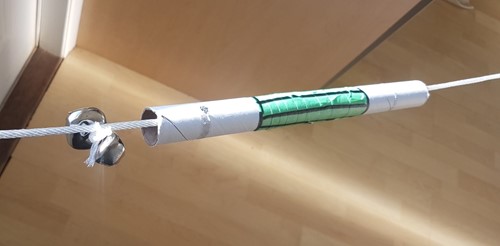
Game of the week
Chair Boccia
Using bean bags or slow rolling balls (i.e. ones partially deflated or something similar) and a target cone or object. It is played with an underhand toss. The object is to toss your bag closest to the target. Each player would get four to throw and the winner is the one with the one closest. Points are awarded for each one closer to the “pin” than their opponent. The target Pin can be identified by sound or light if appropriate. If played outside use balls that roll. Inexpensive water filled balls are available at stores like Walmart.
Websites of the week
Mini-movers is an Alberta based childcare group that has a picture of one way to use the throwing rope
- Another site (Active for Life) with some ideas for the cardboard tube.
- A Victoria BC resource with sport descriptions that can help promote sport activities
Week 6
Skill of the week
Throwing a bean bag for distance
Last week we are introduced throwing overhand. This is an important motor skill to work on to continue to develop better physical literacy. Learning to throw a ball or an object in some manner is difficult for many. We started with using a throwing rope. Today we are going to use our bean bags to throw overhand.
- Have the child stand with their feet shoulder width apart and one slightly forward, with hands by their sides.
- Have them hold their throwing hand straight out waist high with the palm facing up to the “sky”.
- Placed the bean bag in their hand and tell them to turn the hand with the bag over with out dropping it. They should be gently grasping the bag with their fingers spread apart wrapped around, dropping their hand down to the side again.
- The hand and arm with out the beanbag should lift and point in the direction they want to throw.
- The hand with the bean bag reaches back, with the bag on the top still, bending the elbow.
- Have them throw the bag overhand at least head height and at the same time bring the hand without the beanbag back as a pendulum.
- Introduce bending the back knee slightly when preparing to throw.
- Rotate the hips and trunk slightly as they bring the throwing arm forward
- Have them release the bag at 45 degree angle upwards ..ie “towards the top of the trees”
- Introduce a step forward as we did in the throwing rope program
Teaching points
Do not grip the bag too hard.
Bend slightly sideways by bending the back leg knee and leaning slightly backwards when reaching back to prepare to launch the bag.
Have them throw over a barrier of some sort ..for example a fence, clothes line, or garbage cans. Perhaps throw up on to a deck or something similar that will help reinforce height and distance. Use Hula Hoops as targets by shaking them or hanging them up with string from branch etc.
Use bean bag animals or slight deflated balls or sensory balls as a substitute for throwing bean bags.
Use the throwing rope from last week to reinforce the motion of overhand throwing
Use marching drills to retrieve them. Keep up the running exercises!
*Use a hula hoop as a base to throw from to help create a safety zone if mote than one is doing it. It is also a good way to have one foot in and one out to help create separation and a wider base to throw form
Equipment of the week
A wiffle ball to use for many activities. Find any plastic ball that is baseball or softball sized and is hollow with air holes.
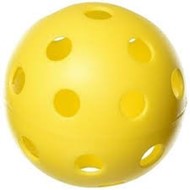
Make a cut in between two of the holes. Push a couple of small jingle bells (available at dollar or craft stores) inside. Run a piece of duct tape around to help seal the hole. If appropriate use a bright colour of tape or if the ball is white a strip of black tape. The tape will help reinforce the ball as well. One way to make a ball useful to visually impaired is to have it move slower. Partially deflating a ball or adding weight can do that!
This ball can be used for a variety of games. Even with some of the holes covered it is still audible. Try different sizes of balls. Pet stores often have balls with bells in them that are soft and pliable as well.
Game of the week
Space walk
Add some science and go for a space walk! Using the hoops and beanbags to explore the planets! Place hoops around the room or yard a few metres apart. Start at one and make a circuit by tossing a bean bag towards the next planet. Once they have landed on that planet (hoop) they try for the next one. Vary the distance and difficulty. Use sound or light to target the planet. Start with Sun and go to Pluto. Try hopping or crawling or different methods to travel. Try different ways of throwing or tossing. Have item they could collect as scientists at each planet that they return to Earth as explorers!
Websites of the week
An American theme this week! There are resources all over the world we can use.
The Northwest Association for Blind Athletes located in the states close to us has a new series of adaptations for sports that they just released that you may find useful. They have worksheets and videos that may help with your students or child
Texas School for the Blind and Visually Impaired (TSBVI) has some online resources that you may find useful!
Week 7
Skill of the week
Hopping and Jumping
Hopping and jumping are motor skills that are useful in many physical activities. Begin with two footed jumps on the spot
- Crouch down with the knees bent and then “explode” upwards, landing on the same spot you jumped from. Use a tactile or visual identification such as a soft mat or use a hula hoop and stay with in it.
- Swing the arms upwards together at the same time the jump happens. You can use a hula hoop or foam swim noodle for them to hold onto to promote confidence as well.
- Landing should be knees bent to absorb the impact. Try it on grass or carpet and avoid concrete. Blacktop roads are even softer than concrete
- When confident have them jump up and touch an elevated object like a noodle
Two footed hopping for distance
- When hopping forward swing the arms forward instead of upwards
- Have a target area to land in using hoops or a colour taped zone
- Guide using hoops or noodles or hockey sticks for them to hold on to at the beginning
- Push off from the toes by rolling forward from the crouch.
- Gradually extend the distance of the targeted landing area
One-foot take-off
Repeat the same skills but on one foot.
- Use a noodle or hula hoop as a stabilizing device for them to hold with one or two hands to help with confidence when jumping
Equipment of the week
Pool Noodle
A handy piece of equipment to have is a set of inexpensive foam pool noodles. They can be used for a variety of fun physical activities. You can throw them like a javelin from track and field as they are easily grasped. They can be used for making boundaries for games that require targeting practice like bowling. They make great markers for safe areas when marching running or jumping. Many of them have a hollow centre and could be threaded on to rope. Make a jump rope with a piece of foam tube to help slow it down and provide a visual clue to help with initiating a jump over the rope. One- or two-pieces work
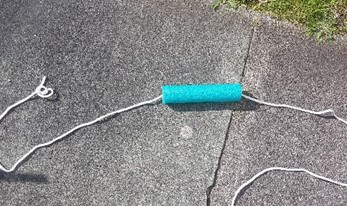
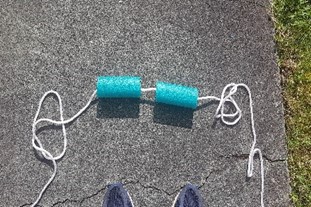
They can be used as a bat for striking games like softball. They can be adjusted to the height of the student with ease. Make circles by duct taping them together
Use them to guide the stroke for golf or hockey shots by lining them up. Use them to help give a tactile guide for the marching drills from previous weeks or use them as a barrier for safety when trying throwing activities
A great guiding tool for holding on to when hopping or jumping in games or movement skills
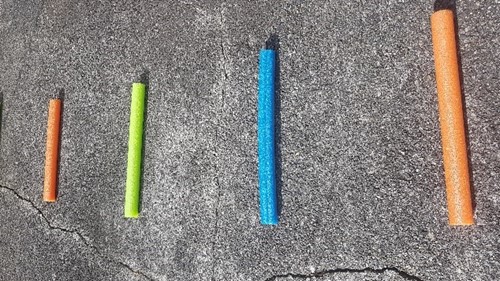
Game of the week
Beans
Travel and move like different sorts of beans.
“jumping Beans” – use two feet
“Beans on toast”- curl up small and still
“Jellybeans”-wobbly body and movement
“Hot Bean” -jumping on one foot
“Runner Bean”-running or marching
“String Bean”- tall stretched out
Play in a safe area allowing for movement. Have them move to a hoop or marked space to perform the movement or bean type.
Websites of the week
Two videos from the United States that have some useful information
Inclusion Series: Track Instructional Video:
Track instructional video on how to coach athletes with visual impairments
Staff Training Video for Physical Education is to educate paraeducators, physical education, adapted physical education, vision teachers, orientation and mobility specialists, and any other staff who teach children in physical education about how to instruct meaningfully during physical education.
Week 8
Wow 8 weeks already! Time to get ready for a Virtual sports day! More information next week!
Hopping and Jumping
Hopping and Jumping: Part 2
This week we proceed to a run and jump activity. Jumping, hopping, or leaping for distance are part of many childhood games and other physical activities throughout school years. Having some body awareness in moving through air is helpful in any physical exercise or games that we all with peers.
Long Jump from standing and from moving forward
Stand on two feet then jump forward. Land like you are riding a motorcycle (squatting with your feet beside each other and hands in front). Try this a few times. Next, take one step then jump forward. Still land like you are riding a motorcycle. Try this 5 times with each leg. Finally, take three steps then jump forward. Land the same way. Try this a few times with walking steps
You can see a quick video of a standing long jump and a hopping video.
Teaching points:
- Use noodles to hold on to help with balance if needed
- Alternate take off legs to help with coordination
- Emphasize Knee lift
- Try softer surfaces to start
- Use contrast or outlined lined areas to promote distances and take off areas. Chalk is a good way to outline areas on pavement
- Have them bend their knees and then “explode up and out”
Game of the week
Activity Wheel
Create a spin dial or wheel to have the child choose what physical activity or game they want to do.
Make a spin dial using an old board game with different exercises printed on it, including things like skipping, running, jumping, hopping or other movement we have covered, or they are familiar already. Use diagrams or braille if appropriate when creating it. A grid diagram would work as well, with a method of randomly choosing the activity. It can be played in a team format with participants choosing for someone else or the other team. Create different dials or grids for games, exercises, or skills. For example, for throwing make a dial with standing, sitting, one hand, opposite hand, types of balls or similar choices could be used.
(thank you to L. Lieberman’s book on Games for People with Sensory Impairments}
Equipment of the week
Skipping rope
Skipping ropes are helpful with developing the jumping skills. You can add foam or plastic segments to help with noise or contrast if needed. Have comfortable handles if possible. Find a whistling rope or tie small bells to the rope for sound.
Can be used for making use of the developing jumping skills but also as a convenient way to outline activity areas for safety or as an object to jump over.

Websites of the week
There are several activities on the “adapted physical education” channel on YouTube that are useful for ideas on adapting motor skill movements
Week 9
Skill of the week
Kicking a ball!
Kicking a ball is a skill that can be difficult for a blind or visually impaired individual. There are several drills that can assist you in developing the skill.
- Use a large and colour contrast ball or one with a sound source in it.
- Have a ball that is soft or partially deflated to prevent it from hurting the foot or travelling too far!
- Create a large targeted area to kick the ball towards. Use sound or light to help with targeting.
- Place the ball on a small flat cone or a slightly raised area to prevent it from moving around when practicing
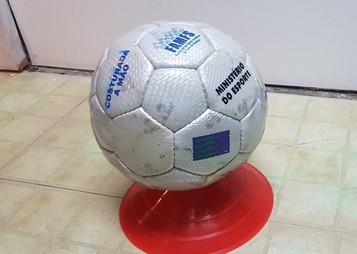
- Have the child choose a foot to use first. Strike the ball with the inside of the foot to start to control it.
- Have them follow through with the foot past the striking point
- Use alternate feet to determine which one works best
- Try different ways of kicking the ball, trying the toes, the instep, and the heel for fun!
- Paint or create a tactile target on the ball itself to help with a better and more efficient kick
- Vary the size of the ball
- Use a sound emitting target such as hanging bells on a net to create some auditory feedback on the success of the kick
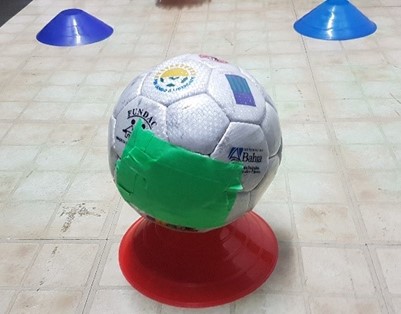
Game of the week
Mini Golf- Putt Putting around the house!
Indoor (or outdoor!) Mini- golf
With many of our normal outdoor fun activities curtailed let us get prepared for those summer trips to the fair or theme parks that will happen soon hopefully!
Mini golf is a popular pastime for all ages! Prepare the children for those days in the future when they go with their friends. We can adapt this game to our current situation of being homebound and limited to activities. It is also a great way to work on fine motor skills and movement control
- Create a mini-golf course using household items! Bowls, laundry baskets and boxes can all be adapted to be “golf holes” We have pots and pans, chairs and tables, stairs and walkways, hallways, and doors. Be creative with what you have. Make the Golf Holes auditory by hanging a small bell in it so the ball rings it.
- Choose a ball that is appropriate for age and size. Use small foam balls or soft play balls that will not break random lamps and windows. Soft floor hockey balls could work.
- Use Solo plastic cups to form the target area or use as hole. All they must do is hit it. Tap it to make an auditory target. Place a small flashing light if that is appropriate to the functional vision that the player has. Play in the dark with glow in the dark mini sticks at each hole.
- Make putters out of cut down hockey sticks, plastic play hockey sticks or foam noodles taped together. Use noodles or sticks to form a guide for those having trouble hitting in a straight line.
- If you have a ball with bells in them use them. Make a ball with good colour contrast to help with location using a wiffle ball
- Cut out a mouse hole in cardboard to make a golf hole.
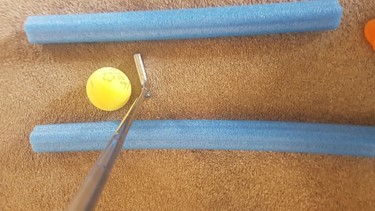
Adaptations
- You can adapt the game by making it into “Bowling Ball “golf by having them roll it with one or two hands!
- Create a ramp to try either putting up hill which requires more force or putting down a slope off a raised tee.
- Name the holes! “Soap and Scrub” for a bathroom hole, “Bedroom Hamper”, “Flowerpot” (in the yard) Have the students come up with the design and name the various holes. Keep score by making score cards to keep track of progress as they get better.
Equipment of the week
We have looked at several pieces of equipment useful for adapting games and physical activities. Many are found in dollar and other similar stores. They can be made at home or school.
Hula hoops, Foam Noodles, Bean bags, Ball in a bag, Wiffle balls, Frisbees, Throwing rope, Plastic cones and Skipping ropes all have multi uses for games.
As part of next weeks Activity try and make or find the various pieces as we prepare for a sports day!
I will be looking for pictures and ideas of what works and what other items are out there as well! Prizes will be involved! Maybe some videos!
Here is a recent video about one of our sports days we have run with our partners at PRCVI and school districts around the province
Websites of the week
BC has been a leader in several sports adapted for the blind and visually impaired. We have resources and contacts for each of these sports. BC hosted the first youth blind hockey programs in Canada and continues to do so. Blind Tennis has also become a popular activity. BC has hosted numerous International and National golf tournaments throughout the years.
Blind tennis
Golf
Canadian Blind Hockey
Week 10 - Sports Day 2020
We have worked on several physical literacy skills for the last few weeks. Its time to put them to use! This is the time of the year most schools have a sports day. This is also when BC Blind Sports hosts a sport and activity day in many areas of the province. This year we will have to do it differently of course!
We want you to try some of the activities and skills listed below. Try as many as you can over the next week or so. Try them with your families. Try them with your friends online by sending them the list and challenging them to a contest!
We want you to send to us pictures or videos of you trying out some of these activities. Show us what equipment you made or used. You can draw us a picture! Try some of the games we told you about earlier.
We also want to hear about other physical activities you have tried while you are at home. Did you go for a bike ride or try a new sport? Did you try dancing! Tell us or show us and why you liked it.
Sadly, we do not have our famous pizza lunch this year but…. We will have some prizes we will send to you if you tell us or show us what you did! We have some adapted equipment that needs a home or some one to play with it!
These activities can be done inside, outside, or even at school for those who are back!
Keep a list of the ones you liked to do! Try one activity from each station listed!
*Teachers and families! Try as many as you can and let us know how they did. There is no minimum number, but we would like a note or pictures or video of the students trying some of these activities or perhaps coming up with their own. If they have made their own adaptive equipment let us see it! We will have some prizes for those who send in something. We will not use any of the images etc. without permission of course.
Try these sports we do at our Sports Day!
Ball Sports- Station One
- Soccer- try kicking and taking a shot on a goal and counting how many you get.Pass the ball at least 10 times
- Ball Hockey- play floor hockey on the driveway or in the basement. Take shots on a net that you made
- Football Toss- try passing the ball to a parent or sibling. Try throwing the ball through a hula hoop someone is holding
- Tennis-try hitting a tennis ball against the wall or over a net on a court
- Basketball- take shots at basketball hoop or make your own!
- Softball- hit a baseball or softball of a tee stand
- Volleyball- use a balloon to practice serving a volley ball serve
Games- Station Two
- Frisbee Golf – Make a golf course for frisbee tossing using hula hoops and cones or boxes and baskets
- Basement Bowling- try bowling with pop cans for targets and a soccer ball for rolling
- California Kickball- try your kick using a soccer ball or a ball with bells and run for the bases
- Soccer golf -use a ball and orange cones to kick your way around a backyard course
- Bocce -play a game with any type of ball (even sock balls!)
Riding and Rolling Activities- Station Three
- Ride a bike or on a bike- try a tandem bike!
- Ride a Stand-up scooter- or sit on a scooter board
- Ride on a skateboard -standing or sitting
- In-line skating- try roller skating
Hula Hoop Games- Station Four
- Hula hoop Toss- throw the hula hoop as far as you can by spinning and turning
- Roll the hoop- Roll the hula hoop along the floor or grass. Spin it to come back to you
- Ring toss with the hoop- try and toss the hoop over a target like a cone or box
- Skip with a hula hoop
- Spin the hoop around your waist- try more than one!
Movement Activities- Station Five
- Walking -try walking fast, marching slow and fast, walking backward
- Skipping- try fast and slow skipping with and without a skipping rope
- Hopscotch- make a hopscotch design for others to try hopping through by using hoops or chalk on the sidewalk
- Dancing – dance to different kinds of music and songs
- Tag- play different kinds of tag with your family- balloon tag, frozen tag
- Obstacle course- create and run through an obstacle course that has sections to crawl under and hop over.
- Parachute- use an old sheet or blanket for parachute activities such as creating waves, lifting it up and down, and tossing balls or soft objects into the air. Run under, sit under it or spin it around.
Challenge your strength- Station Six
- Standing long jump-try 4 standing jumps to see how far you can get
- Wall sit- see how long you can hold your back against the wall with your hands on your knees
- Balance Beam-try standing on one leg and balance using small board on the ground or a towel or rubber mat
- Jump up-stand by a wall and jump straight up, marking where you touch-try 3 times making sure you use all your power!
- Distance Kick-see how far you can kick a ball standing still. Then try taking 3 steps and kicking it
- Sit ups- how many sit-ups can you do in 1 minute or 2 minutes!
Relays!
The highlight of our BC Blind Sports Activity days are the relays! 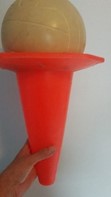
Try some of these at home or outside on the grass. Have the student run 10-20 metres or more around an object and back. The older the longer the run!
- Sack Race- Pillow cases work if you do not have a potato sack 😊- hop down and back holding on to the sack with your feet inside. If in a chair drape it over their legs
- Ice Cream Cone Relay- (aka Egg and Spoon) Use an upside-down plastic cone with a ball on top for the ice cream
- Hula Hoop Relay- run to the other end and back holding the hoop. Pick up another person and both hold on and run down and back. Add another person each time.
- Big Shirt Relay- Run to the cone and put on a big t shirt, then run back and take it off and hand to the next person
- Items Relay- Have 5 to 10 items in a hoop at the other end. The student runs down and picks up item and brings it back and places it in a hoop at the starting point. You can vary it by having them put the items on a frisbee and carrying them that way.
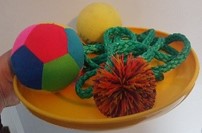
- Crab Walk Crawl- crab walk down and back.
Tug of war! Unfortunately, not everyone has a tug of war rope! We miss that as it is a highlight of every sport day we do!
NEXT YEAR!
Quicklinks